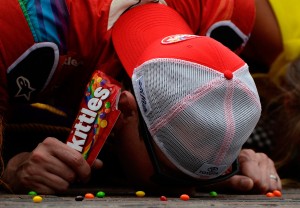
Ah, Indianapolis. The most hallowed speedway in all the country. Gasoline Alley stands tall as drivers enter the garage. Every bit of the track is asphalt, including pit road and the infield. That is except for one yard of bricks on the racing surface, honoring the original track and the history it represents.
This year’s race also marked a new aerodynamic package that was tested, hoping to create more passing on the big tracks.
Unlike Kentucky, this package used was not to create less downforce. Instead, it was a high-drag package that put a big hole in the air, hoping to let the car behind pull up and make the pass.
What the package consisted of was a massive, nine-inch spoiler, complete with a one-inch wicker bill at the top. It also had a rear fascia extension similar to what would be seen at Daytona and Talladega.
Cars also had a two-inch leading edge of the front spoiler, along with a 43-inch radiator pan.
So how did it fair: pathetic.
The package that made the cars have a higher drag ratio instead of downforce yielded only 16 lead changes, and trying to pass on the track was nonexistent unless it was done on a restart, on pit road, or if the draft worked out perfectly, a slingshot pass entering turns 1 or 3. Outside of that, the racing was typical of what Indianapolis has provided, which is a flat track that is hard to pass, especially with low banking in the corners.
Let’s face it, these cars are not like the open-wheel machines that take to this track in May. They are heavy, wide, and the tires make a big footprint.
But, this package simply made it worse. Weeks ago, when the new package with low downforce and a shorter rear spoiler was used in Kentucky, it was an exceptional race where the drivers themselves put a lot of input in the car and it led to some great action. Here, it was more about the car, and the work the team did at the shop, instead of what the driver does on the track.
Currently, the next race for this package is slated to be in Michigan next month, while the Kentucky package is set to be used in September at Darlington. NASCAR may have to rethink that idea because what Indianapolis got was what is typical for this sport at this track.
Was it as bad as when the tires turned to dust every 11 laps and NASCAR had to throw the caution to prevent blowouts, no, but still it was bad.
Back to the drawing board it appears.
RESULTS: 1-Kyle Busch 2-Logano 3-Harvick 4-Truex Jr. 5-Hamlin 6-Bowyer 7-Kenseth 8-Kurt Busch 9-Larson 10-Keselowski
NOTABLE FINISHES: 13-Edwards 15-Johnson 22-Earnhardt Jr. 28-Stewart 42-Gordon
CAUTIONS: 9 for 36 laps. Lap 46-49 (Debris-BS); 51-54 (No. 15, 24 accident-T3); 92-96 (Debris-FS); 108-111 (No. 43 spin-T2); 121-124 (No. 33 accident-T2); 142-146 (Debris-BS); 149-152 (No. 88 accident-T1); 156-158 (Debris-T2); 160-162 (No. 6 accident-T1).
LEAD CHANGES: 16 among 6 drivers. C. Edwards POLE; J. Logano 1-11; C. Edwards 12-31; K. Harvick 32-45; J. Logano 46-61; K. Harvick 62-83; B. Keselowski 84; Kyle Busch 85-92; K. Harvick 93-120; D. Ragan 121-123; B. Keselowski 124; D. Ragan 125-126; B. Keselowski 127-141; K. Harvick 142-152; Kyle Busch 153-161; J.
Logano 162; Kyle Busch 163-164.
TIME OF RACE: 3 Hrs, 6 Mins, 51 Secs.
AVERAGE SPEED: 131.656 MPH
MARGIN OF VICTORY: 0.332 Seconds
CHASE GRID: 1. Johnson-675 (points), 4 (wins); 2. Harvick-777, 4; 3. Earnhardt Jr-677, 2 wins; 4. Kurt Busch-612, 2; 5. Logano-708, 1; 6. Truex Jr-668, 1; 7. Keselowski-638, 1; 8. Kenseth-615, 1; 9. Hamlin-591, 1; 10. Edwards-519, 1; 11. McMurray, -175 (from 1st); 12. Gordon, -202; 13. Newman, -214; 14. Menard, -219; 15. Kahne, -219; 16. Bowyer, -239.
*Kyle Busch sits 32nd in points, 27 points outside of the top-30, with four wins. He must make the top-30 to be Chase eligible.